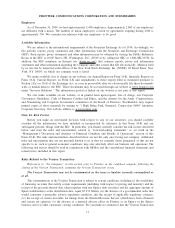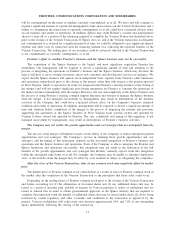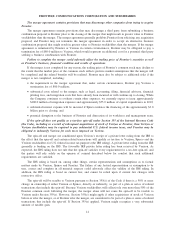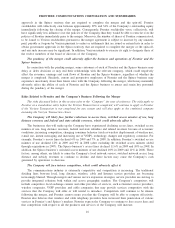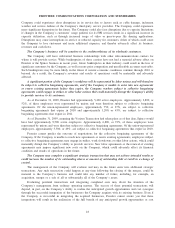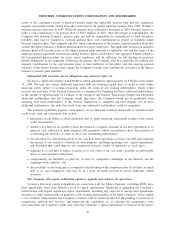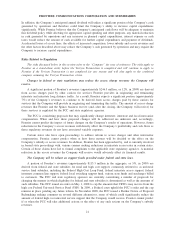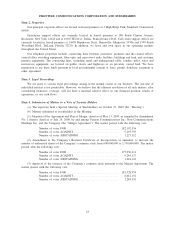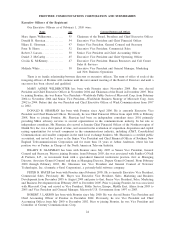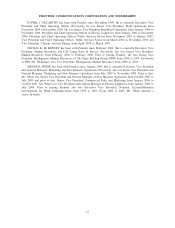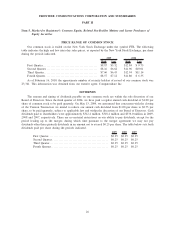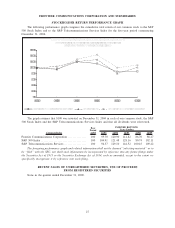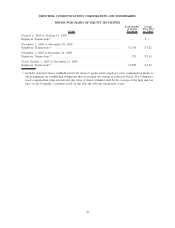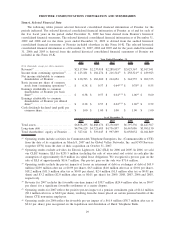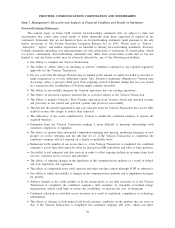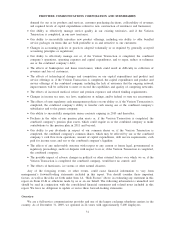Frontier Communications 2009 Annual Report Download - page 23
Download and view the complete annual report
Please find page 23 of the 2009 Frontier Communications annual report below. You can navigate through the pages in the report by either clicking on the pages listed below, or by using the keyword search tool below to find specific information within the annual report.In addition, the Company’s anticipated annual dividend will utilize a significant portion of the Company’s cash
generated by operations and therefore could limit the Company’s ability to increase capital expenditures
significantly. While Frontier believes that the Company’s anticipated cash flows will be adequate to maintain
this dividend policy while allowing for appropriate capital spending and other purposes, any material reduction
in cash generated by operations and any increases in planned capital expenditures, interest expense or cash
taxes would reduce the amount of cash available for further capital expenditures and payment of dividends.
Accelerated losses of access lines, the effects of increased competition, lower subsidy and access revenues and
the other factors described above may reduce the Company’s cash generated by operations and may require the
Company to increase capital expenditures.
Risks Related to Regulation
The risks discussed below in this section refer to the “Company” for ease of reference. The risks apply to
Frontier as a stand-alone entity before the Verizon Transaction is completed and will continue to apply to
Frontier if the Verizon Transaction is not completed for any reason and will also apply to the combined
company assuming the Verizon Transaction closes.
Changes in federal or state regulations may reduce the access charge revenues the Company will
receive.
A significant portion of Frontier’s revenues (approximately $246.3 million, or 12%, in 2009) are derived
from access charges paid by other carriers for services Frontier provides in originating and terminating
intrastate and interstate long distance traffic. As a result, Frontier expects a significant portion (approximately
7%) of the Company’s revenues to continue to be derived from access charges paid by these carriers for
services that the Company will provide in originating and terminating this traffic. The amount of access charge
revenues that Frontier and the Spinco business receive (and, after the closing, the Company will receive) for
these services is regulated by the FCC and state regulatory agencies.
The FCC is considering proposals that may significantly change interstate, intrastate and local intercarrier
compensation. When and how these proposed changes will be addressed are unknown and, accordingly,
Frontier cannot predict the impact of future changes on the Company’s results of operations. However, future
reductions in the Company’s access revenues will directly affect the Company’s profitability and cash flows as
those regulatory revenues do not have associated variable expenses.
Certain states also have open proceedings to address reform to access charges and other intercarrier
compensation. Frontier cannot predict when or how these matters will be decided or the effect on the
Company’s subsidy or access revenues. In addition, Frontier has been approached by, and is currently involved
in formal state proceedings with, various carriers seeking reductions in intrastate access rates in certain states.
Certain of those claims have led to formal complaints to the applicable state regulatory agencies. A material
reduction in the access revenues the Company will receive would adversely affect its financial results.
The Company will be reliant on support funds provided under federal and state laws.
A portion of Frontier’s revenues (approximately $113.3 million in the aggregate, or 5%, in 2009) are
derived from federal and state subsidies for rural and high cost support, commonly referred to as universal
service fund subsidies, including the Federal High Cost Loop Fund, federal interstate access support, federal
interstate common line support, federal local switching support fund, various state funds and surcharges billed
to customers. The FCC and state regulatory agencies are currently considering a number of proposals for
changing the manner in which eligibility for federal and state subsidies is determined as well as the amounts of
such subsidies. The FCC issued an order on May 1, 2008 to cap the amounts that CETCs may receive from the
high cost Federal Universal Service Fund (USF). In 2009, a Federal court upheld the FCC’s order and the cap
remains in place pending any future reform. In November 2008, the FCC issued a Further Notice of Proposed
Rulemaking seeking comment on several different alternatives, some of which could significantly reduce the
amount of federal high cost universal service support that the Company would receive. Frontier cannot predict
if or when the FCC will take additional actions or the effect of any such actions on the Company’s subsidy
revenues.
21
FRONTIER COMMUNICATIONS CORPORATION AND SUBSIDIARIES


